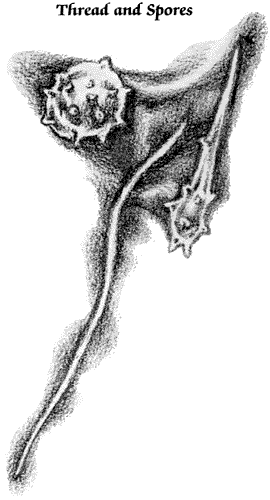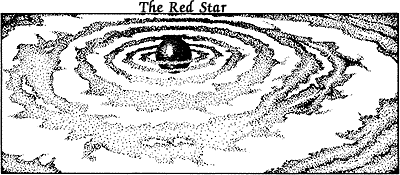
| Разделы | |||||||||||||||||||||
|---|---|---|---|---|---|---|---|---|---|---|---|---|---|---|---|---|---|---|---|---|---|
| @ Иллюстрации и Обложки | |||||||||||||||||||||
@ Книги
| |||||||||||||||||||||
| @ Планета Перн | |||||||||||||||||||||
| @ Драконы и файры | |||||||||||||||||||||
| @ Дельфины | |||||||||||||||||||||
| @ Биология | |||||||||||||||||||||
| @ Общество | |||||||||||||||||||||
| @ Родословные | |||||||||||||||||||||
| @ События | |||||||||||||||||||||
| @ Энциклопедия | |||||||||||||||||||||
| @ Улыбнитесь | |||||||||||||||||||||
| @ Гостевая книга | |||||||||||||||||||||
| last modified
23.01.2005
|
|---|
Всадники Перна. Материалы
The Dragonlovers guide to pern
The Red Star
Thread!
The Exploration and Evaluation Corps team had noticed the eccentric planet on its irregular circuit through the plane of the ecliptic. The team noted in its report that the planet must have been captured by the gravity well of Rukbat, and was unable to escape from the orbit. They judged that its period of revolution was somewhat over two hundred years.
The face of the rogue planet seemed to be made up of formations of heavy gases that changed only rarely under tornadic winds of lighter gases that ripped across the surface. The team assumed severe tectonic conditions underneath the gases because of the tremendous and irregular pull the rogue suffered from Rukbat.
Though they had seen other worlds stripped bare by unknown agencies thought to have to do with those systems' Oort clouds, the EEC team considered that they had too little time and data to determine the cause of the curious overlapping circles of denuded earth and stone on the third planet. One of the team cited the theory of “space viruses” propounded by Hoyle and Wickramansingh, a theory that some considered to be discredited by scientists on Ceti III. But the idea of a mass extinction seemed unlikely, judging by the speed at which the ground vegetation was regenerating. Observing that where the circles touched one another, they stopped expanding, the team judged it to be the work of a local fungus. No blame was accorded to the wandering planet next out from the sun.
The tragedy of the events in the colony's eighth year was that the colonists knew that the rogue planet was dragging Oort material after it, and they knew that Pern would pass through the contrail again and again. If the Oort cloud had been composed of large particles and chunks, as was the case in other stellar systems with which the FSP were more familiar, it would have produced a showy meteor shower as the particles entered Pern's atmosphere, not the decimation by Thread that befell. It was not until the Pass began that the biologists understood why they found no plants older than a few centuries, and why those that existed grew up very quickly. The biosphere was not depauperate but survivalist.
As it was, the colony was completely taken by surprise. Hundreds of people died in the First Fall. Nothing was left of the hapless victims but whatever pieces of metal they had been wearing. Many victims were burned and scarred by Thread before their dragonets flamed the remains or drove the victims into the water to kill the mycorrhizoid.
The Fall began east of the Jordan River and continued southwest, striking seven stakeholds in Jordan and Kahrain provinces. The next wave hit Macedonia, and apparently doubled back to strike the as yet unoccupied Bordeaux stakehold.
Numerous animals, mostly sheep and cattle, were lost in the first Fall experienced by the humans, which was actually the fourth Fall of the Pass. Twenty-three
precious mares and a stallion were consumed before the shocked settlers could get their stock under cover. Humans struck by the filaments appeared to dissolve as the Threads engorged, and died
painfully.
When Thread began to fall, the dolphins alerted the mariners to the curious behavior of the ocean's inhabitants. Fish and sea creatures followed the Leading Edge, swarming to eat Thread as it fell in the water. Later investigations disclosed helpful variables: Hot thermals from forest fires often ignited falling Thread, preventing it from reaching the ground. Wet or extremely cold weather destroyed Thread in the air; rain and snow caused messy clumps of decayed Thread to fall from the sky. Cold froze the hot Threads into harmless black “crackdust." Since water, stone, and metal were unaffected by Thread, caves and stone buildings, tin-roofed Quonset huts, lakes, and rivers were potential havens from a Fall. Not all the settlements were immediately affected, but Landing realized that if the attacks continued, no place on Pern would be safe. At first it was hoped that Thread was a sporadic or temporary occurrence, but reexamination of the EEC reports proved that the incursions were planetwide.
DEFENSE
Once the pattern of the attacks was determined, the colonists looked for defensive measures. Flamethrowers were mounted on either side of the transport sleds, and pilots pursued the Leading Edge of Fall until it was beyond vulnerable human habitations. In the beginning, there were a lot of midair accidents—although most of the pilots were expert at flying sleds, they were not accustomed to flying in such close formation or combating such a widespread menace. In order to avoid collision and maximize their efficiency, it was decided to maintain certain altitudes, fly static patterns to the edge of Fall, then turn and repeat the pattern at the same altitude across the deadly rain. Flying into the Leading Edge, the rear openings of the sleds were protected unless someone missed too much Thread and the wind currents swept it under the canopy. The sleds flew toward the Thread, blazing away with both guns.
Thread that had not been destroyed burrowed deep into the soil and consumed all plant life for a considerable radius. Acid, specifically nitric acid, HNO3, was poured on infestations. Where pumps were available, water was flushed down Thread burrows, but that brought the sticky dead mess up to swirl around the feet of the defenders.
The settler's pet dragonets had a more personal survival mechanism. By chewing phosphine-bearing rock, they produced an internal gas that ignited into flame upon contract with oxygen, They protected many homes that had been constructed of vegetable plastic or wood, neither of which could withstand Thread. Many observed their behavior, but few recognized their potential as protectors of the settlements.
APPEARANCE AND BEHAVIOR OF THREAD
Thread begins as a spore in the icy cometary trail following the Red Star. As it is captured by planetary gravity it elongates into a slender filament heated by the fiction of is fall through the atmosphere.
Observation of living Thread is difficult, since it seems to have no more then twenty minutes of life-unless it was fed carbon-based compounds. A risk of their own lives, volunteers brought samples of Thread to the biologists' laboratory.
Thread was discovered to be a network of mycorrhizoid, similar to a harmless Earth mycota which was symbiotic with same plants. Carbon-based thread contains very large, complex proteins that enable it to move and burrow or to digest any organic substance.
Not all Thread is dangerous. Some of the mycorrhiza die on the surface, without penetrating the ground or consuming nutrion. Thread leaves behind shells, which quickly deteriorate in the open air. Some Threads mature, thought the further life cycles were never discovered by the colonial scientists.

Feeding Thread charges color, shifting from its normal hot silver to sickly green, gray, pink, and yellow tones. It appears to elongate from the center of the original strand outward toward both ends.
Threads hiss and struggle energetically when captured. The original strand was only 1/4 inch wide but 98 feet long. By the time one captured Thread replicated itself several thousand times , it had engorged to nearly 470 feet long and three feet thick.
When a Thread “dies”, its cooling silver surface blackens and decays into a
tarry substance within its tough shell. The sells quickly become putrid. When
those are burned or dissolved with acid, they produce an incredible stench. Fire
and water were the colonists' best weapons against Thread.
When F'nor of Benden and brown dragon Canth went between to the Red Star in the Ninth Pass, they encountered some Thread spores in the atmosphere, but it was the cyclonic dust clouds spinning through the atmosphere that sanded their skin and hide bare. Because of the conditions on the Red Star, F'nor could offer little firsthand observation of any use to the dragonriders who were eager to burn Thread at what they believed to be its source. All research on the Oort cloud had been long lost by that time.
The Dragonriders of Pern ® is a registered trademark.


